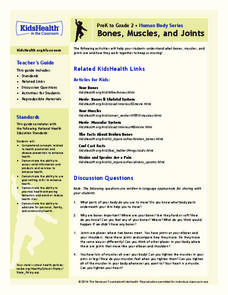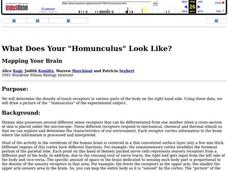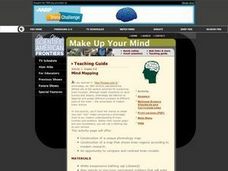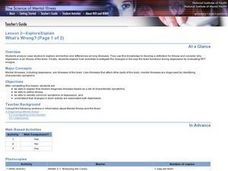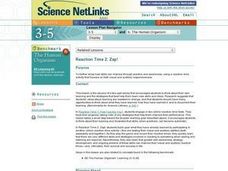Curated OER
The Man Who Mistook His Wife for a Hat
Four scenarios of unusual human behaviors are given to your psychology class. Based on their knowledge of brain anatomy and function, they consider what parts of the brain might be affected in order to result in the behaviors. This case...
Curated OER
Nervous System
Are you nervous about teaching the nervous system to your beginning biologists? Worry no more! This PowerPoint provides a note-taking guide and diagrams of the neuron and the brain. Viewers will walk away with a clear...
Nemours KidsHealth
Concussions: Grades 3-5
Two lessons focus on concussions. The first lesson uses cards and role-playing to detail signs of a concussion. Through readings, discussions, and worksheets, the second lesson looks closely at parts of the brain and offers ways to keep...
Curated OER
Disorders of the Brain
Students, in groups, conduct research about a specific disorder of the brain, create a character study of a person with that brain disorder, and then present the information to the rest of the class.
Curated OER
Nervous System
Get to know the body's central nervous system through an engaging game of nervous system telephone. But this isn't your average game of telephone. Here, pupils must find a way to communicate a message to the brain without speaking....
Curated OER
Brain Manipulative Model
Students visualize the major human brain divisions by using a manipulative puzzle to discover the names and functions of the regions. They use this hands-on anatomy aid to study the braqin regions.
Curated OER
Entering the Eye
The human eye is the focus of this biology PowerPoint. The presentation takes a virtual trip inside of the human eye and allows learners to view the various parts of the eye. The best part (for me) are all of the optical illusions that...
Curated OER
Congruent Polygons: Copying Stretchy Shapes
Third graders investigate congruent polygons through dance. In this congruency lesson plan, 3rd graders do the "brain dance" as a warm up. They review polygon names by singing "The Polygon Chant," before mirroring congruent shapes with a...
Nemours KidsHealth
Bones, Muscles, and Joints
What is the hip bone connected to? Learn about body parts and the human skeleton with a game of Simon Says, skeleton puzzle, and five question quiz.
EngageNY
Evaluating Sources, Continued: The ONLINE EDUCA Debate 2009 (Part 2 of 10)
Watching videos and playing online games can be educational, but too much screen time has its drawbacks. Pupils watch a video about the topic and write down the claim, reasons, and evidence in support of reduced screen time for children....
Curated OER
The Brain Reflex System And How It Works
Young scholars explore reflexes. For this biology lesson plan, students discover the basic facts about the reflex systems of the brain as they take part in hands-on activities.
Curated OER
How We Learn About the Brain: Teaching the Infant Brain
Students describe the development of an infant from conception to birth. In this biology lesson, students discover how a child's brain develop. They explain how children acquire motor and cognitive skills.
Curated OER
Eye Parts
In this eye parts worksheet, students match the eye part to its definition and label the diagram. Students complete 11 problems.
Curated OER
ESL Body Parts 2 Matching Worksheet
In this ESL body parts matching worksheet, 4th graders match 10 clip art pictures of body parts to their names. They match names such as belly, ankle, hand, and brain.
Curated OER
Parts of the Ear
In this online interactive parts of the ear learning exercise, students respond to 7 multiple choice and fill in the blank questions regarding the information included in the provided paragraphs.
Curated OER
The Nervous System
In this nervous system instructional activity, students complete a crossword puzzle given 15 clues about the structures of the nervous system such as the brain and spinal cord and the functions of the nervous system.
Curated OER
Coping with Changes
Students build on knowledge of brain and nervous system in order to write about how their nervous systems help them cope with change in environment. Students navigate online sites to explore different parts of brain and nervous system.
Curated OER
What Does Your "Homunculus" Look Like?
Young scholars investigate the density of touch receptors in various parts of the body. They discover how the body senses various stimuli, then maps a picture of the "homunculus" of the experimental subject.
Curated OER
The Nervous System
Students investigate the nervous system. In this anatomy lesson plan, students identify and define vocabulary related to the nervous system. Students role play the parts of a nervous system and perform an experiment measuring and...
Curated OER
Mind Mapping
Students explore the functions of the brain. They create their own "live" model comparing a phrenology chart to our modern understanding of brain function and anatomy. Students compare and contrast brain models.
Curated OER
Teaching Neuro-anatomy Through Schematic Diagrams
Students develop a deeper understanding of the brain. In this neuro-anatomyl lesson plan, students will use simple diagrams to understand the brain and will progress to more complex diagrams as they gain understanding.
Curated OER
What's Wrong?
Students analyze case studies to explore similarities and differences among illnesses. PET images are examined to explore how scientists investigate the changes in the way the brain functions during depression.
Curated OER
Reaction Time 2: Zap!
Learners explore critical thinking by conducting a reaction time experiment. In this human brain lesson, students utilize a timed Internet worksheet activity to research how fast their brain works when answering questions. Learners share...
Curated OER
Brain Watching
Students identify the different parts of the nervous system. In this biology lesson, students research methods to diagnose and cure neurological disorders. They present their report to class.
Other popular searches
- Parts of the Brain
- Parts of the Human Brain
- Parts of Brain
- The Parts of the Brain
- Brain Parts and Functions








